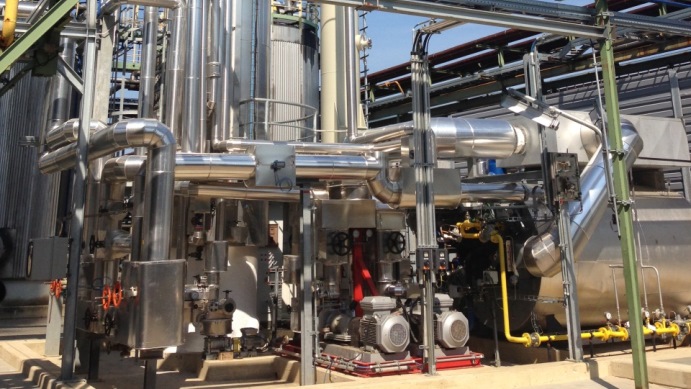The specialist for industrial process heat, heat transfer and electric power generation, heat 11 from Bielefeld, Germany, has successfully commissioned a plant for the heat supply of two reactors. The reactors are used for the manufacturing of high purity paraffin for medical products. Plant operator is company H&R AG, as specialty chemicals company from Salzbergen (Germany), a producer of chemical-pharmaceutical specialty products based on crude oil and precision plastic parts.
The photo shows the thermo oil plant with boiler plus overhead combustion air preheater on the right side, a double pump group, a combined expansion and collection vessel (left) and the chimney.
The plant consists of a gas fired heater with a heating capacity of 2.000 kW with one burner featuring a particularly wide control range from 1:10. According to the company this is reached by a special gas burner of company SAACKE from Bremen which makes this regulation all possible with its double gas ring.
High plant efficiency despite high temperatures
Manufacturers and operators are particularly proud of the particular efficiency of the plant which had been achieved despite a high flow temperature: “The plant is operated with an inflow temperature of 375 °C. But even at these high temperatures we still reach an efficiency of over 90 %!” so Dr. Dietmar Hunold, general manager of heat 11.
This high efficiency is reached by a combustion air preheat to 210 °C and an O2-regulation of the combustion process. Heaters with heat recovery units are part of the heat 11 product range to increase the energy efficiency. A synthetic heat transfer liquid, Therminol 72 is used as heat transfer medium which is used in the range of -10 °C up to 380 °C.
Redundant design
But also beyond this, high expectations were placed on the plant: “As per our strict factory specifications the plant had to be designed with full redundancy and equipped with a volume flow rate.”, Erich Weitzel said, operations manager of H&R. “Further characteristics in the tender were the strict noise emissions (85 decibel) and the design of expansion and collection vessel which were designed as combined vessel“, Weitzel continued.
The plant runs smoothly since the successful commissioning. This is due not least to the good cooperation of plant operators and manufacturers.





Comments are closed.